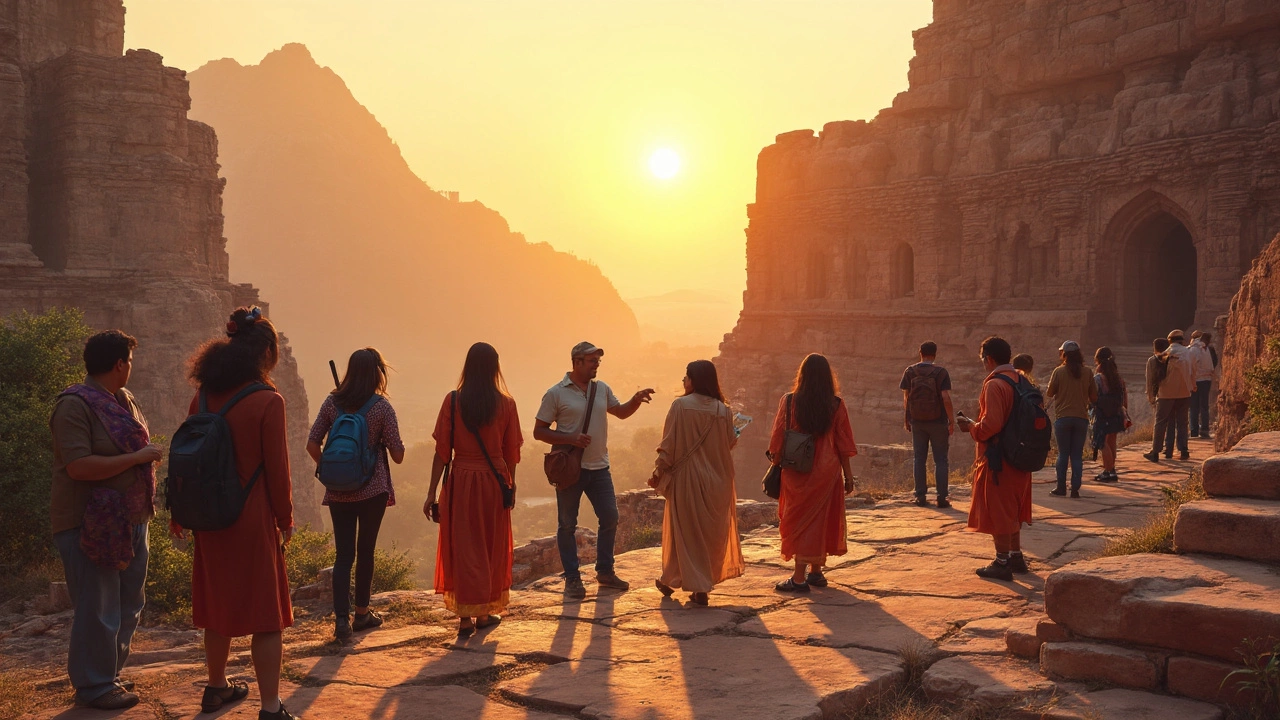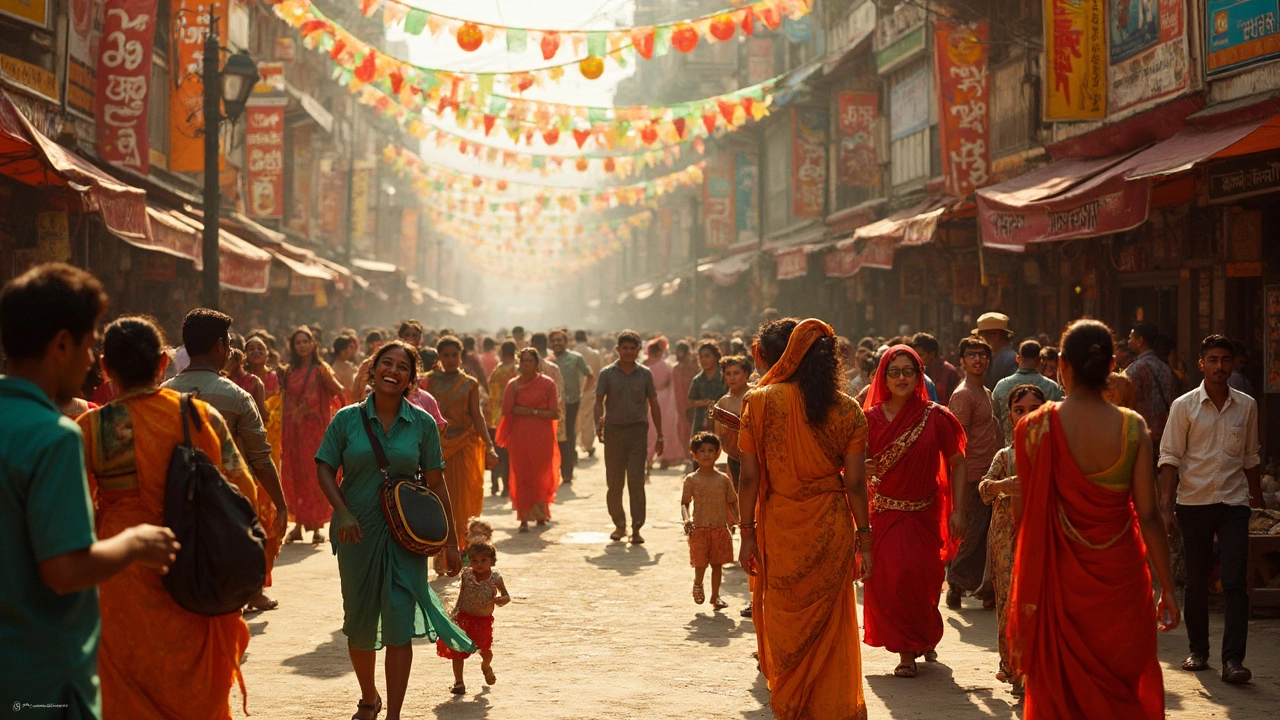People don’t all travel for the same reasons. Some are obsessed with crumbling forts, while others can’t stop talking about the shawarma they had on a street corner in Delhi. When it comes to cultural tourism in India, travelers usually fall into five main categories—and knowing where you fit can totally change your trip for the better.
If you find yourself drawn to old palaces or ancient temples, you’re probably in good company with the heritage hunters. These travelers are always hunting stories in ruins, museums, and age-old cities. But you might also be the type who times your vacation around Holi or Diwali, just to experience those wild, unforgettable festivals. Others, believe it or not, come all this way for the art—think pottery in Rajasthan or textile weaving in Gujarat.
And let’s not forget about food. Some cultural tourists in India basically plan their day according to what they’ll eat next. Ever heard someone brag about having ten different kinds of chaat in one afternoon? That’s your classic culinary culture seeker. There are also travelers who look for real-life experience—staying in a family homestead, taking cooking lessons, or learning a bit of Hindi. Each type has its own way of getting under the skin of India’s chaotic, colorful culture.
If you’re wondering which type you are, keep reading. I’ll share easy ways to spot each group and give a few tips from personal experiences—plus some fun stories that might surprise you. Trust me, there’s more to being a cultural tourist in India than just checking off the Taj Mahal.
- Who Are the Heritage Hunters?
- Festival Fanatics in India
- Art and Craft Explorers
- Culinary and Living Culture Seekers
Who Are the Heritage Hunters?
Heritage hunters are the type of cultural tourists who can't get enough of India’s old stories and forgotten corners. They’re the ones snapping photos at the Red Fort or wandering the narrow lanes of Hampi at sunrise. If you ask them why they travel, you’ll get long talks about Mughal kings, lost empires, or even why Rajasthan’s forts look more dramatic than any movie set.
What really drives these folks is a deep curiosity about the places that shaped India’s present. They usually have a checklist of UNESCO World Heritage Sites, and they’ll gladly wake up at 5 am to beat the crowds at the Taj Mahal. Their travel is anything but random—map in hand, they move from ancient temples in Tamil Nadu to colonial-era churches in Goa, soaking up every detail.
Here are some signature moves of a heritage hunter in India:
- They geek out over guided tours, especially when the guide shares a weird or surprising historical nugget—like how Fatehpur Sikri was abandoned because the water supply ran out.
- They read every sign at the museum, even the ones everyone else skips.
- Cameras and notebooks are always in hand, just in case they spot a carving or painting worth remembering later.
- Street food rarely wins over them unless it’s tied to a centuries-old tradition.
India’s top destinations for these tourists aren’t just the usual suspects like Agra and Jaipur, by the way. Ever heard of the Group of Monuments at Pattadakal? Or Bhimbetka rock shelters? These lesser-known gems are pure gold for someone who truly loves Indian culture and history.
| Top Heritage Sites Visited in India (2024) | Number of Annual Visitors (approx.) |
|---|---|
| Taj Mahal, Agra | 8 million |
| Qutub Minar, Delhi | 3.5 million |
| Hampi, Karnataka | 1.1 million |
| Khajuraho Group of Monuments | 0.7 million |
If you’re planning to be a heritage hunter, a simple tip: always check for local storytelling walks—many cities now have these, blending quirky facts with real history (and none of the boring lecture stuff). You’ll walk away knowing more than most locals. And snag your tickets online where possible, especially during festivals and winter, when tourism is booming.
Festival Fanatics in India
There’s a special breed of cultural tourists who time their trips just for India's mind-blowing festivals. These are the festival fanatics—the ones who plan months ahead just to catch Holi’s color throws or the midnight madness of Diwali. If you think Indian festivals are just for locals, think again. Last year, over 2 million international tourists visited during festival months, mostly to experience the real buzz of Indian celebrations.
India easily racks up more festivals than there are days in the year. Take Kumbh Mela, for example—this religious gathering draws nearly 50 million people to the banks of the Ganges. Not far behind are music and dance festivals like Jaipur Literature Festival and Goa Carnival. Each event is an explosion of local traditions, and no two festivals feel the same.
- Holi: Best if you don’t mind getting drenched in colors—or water balloons. Celebrated in March everywhere from Mathura to Udaipur.
- Diwali: The festival of lights. Cities like Varanasi look like they’re on fire (in a good way)—think floating candles, fireworks, and boxes of sweets on every corner.
- Pongal: Head down South to Tamil Nadu in January. You’ll see bull races, rice art, and taste the best jaggery sweets around.
- Durga Puja: If you’re a fan of massive statues and midnight processions, Kolkata is the place in October.
- Pushkar Camel Fair: Not just about camels, but also folk music, acrobatics, and the occasional moustache competition in Rajasthan.
Here’s a quick table with top Indian festivals and the best places to catch them:
| Festival | Best Location | Month |
|---|---|---|
| Holi | Mathura, Vrindavan | March |
| Diwali | Varanasi, Jaipur | October/November |
| Durga Puja | Kolkata | September/October |
| Pongal | Chennai, Madurai | January |
| Kumbh Mela | Prayagraj, Haridwar | Every 12 years |
Big tip: Book everything months ahead, especially for Kumbh Mela or Durga Puja, since hotel rates can double. And don’t just watch from the sidelines—join a local family, take part in the rituals, and try festival food stalls. It’s all about jumping into the chaos, not just snapping photos for your feed. Remember, India’s festivals are high-energy and totally unpredictable, but that’s what makes them unforgettable for any cultural tourist in India.

Art and Craft Explorers
If you ask me, cultural tourists who are into art and craft see India like a massive open-air museum. These folks search markets, workshops, and quiet villages for hands-on traditions you just don’t get at big tourist spots. Art and craft explorers don’t just snap photos; they want to watch block-printing in Rajasthan, try their hand at Madhubani painting in Bihar, or pick up blue pottery in Jaipur. You might even spot them bartering for embroidered textiles in Kutch or picking through Dilli Haat’s mountain of handmade trinkets.
Real talk—India is home to over 3,000 traditional crafts, many of which are centuries old. From brassware in Moradabad to sandalwood carving in Mysuru, the options are almost endless. Don’t be surprised if you find artists shaping clay pots without a spinning wheel in Manipur or watch a weaver working on a sari for months in Varanasi. Craft traditions aren’t just for show here; it’s how a lot of families still earn their living.
| Region | Famous Art/Craft | Unique Fact |
|---|---|---|
| Rajasthan | Blue Pottery | No clay, made from quartz and glass |
| West Bengal | Terracotta | Used for ancient temple décor |
| Odisha | Pattachitra Painting | Painted with only natural colors |
| Kutch, Gujarat | Mirror Work Embroidery | Passed down through generations of women |
For anyone serious about seeing these crafts in action, skip the souvenir shops in big malls. Instead, head to smaller workshops, government-run emporiums, or village fairs like Surajkund Mela. Want to level up? A lot of artists offer quick DIY sessions where you can make your own paper mache mask, paint dokra figurines, or spin yarn. Trust me, it’s a whole different vibe when you walk away with something you made yourself.
One last tip: Respect the artists. Bargaining is normal, but don’t nickel and dime someone who’s keeping a 200-year-old art form alive. And if you’re buying stuff for friends back home, make sure to ask about the craft’s story. It’s great to share, and you’ll sound like a real India travel pro.
Culinary and Living Culture Seekers
If your favorite way to learn about a place is through your taste buds or by jumping into the daily lives of locals, this group has your name all over it. Cultural tourists in this category are less about just looking and more about doing, smelling, eating, and joining in.
First up—food. From the thali plates in Kerala to street dosas in Chennai, India is a goldmine for culinary adventure. India is home to more than 30 different regional cuisines. That sounds wild, but it checks out. Take Gujarat and Bengal: one loves sweets, the other loads up with spices and fish. Street food is another level here—Delhi’s Chandni Chowk area dishes out chaat favorites like pani puri and aloo tikki, and queues for these can rival those outside cricket stadiums.
For living culture seekers, it’s about everyday life. These travelers look for homestays over hotels, actual cooking classes instead of just restaurant meals, and might even jump into a local cricket match or attend a Bollywood dance class. They’re the types who pick up enough Hindi to order chai without getting ripped off.
Want to make the most out of this style of cultural tourism in India? Here are a few real-deal tips:
- Pick a region for depth, not just for variety. Spend a week in Tamil Nadu or Punjab instead of barely skimming five cities.
- Join local food tours. They’re perfect for tasting safely and understanding weird but delicious flavor combos (ever tried mango with chili salt?).
- Opt for homestays and Airbnb experiences. These often include meals, family stories, and activities you won't find in guidebooks.
- Take short classes. Whether it’s pottery in Jaipur or learning to tie a sari in Varanasi, you’ll get street cred and more laughs than reading a travel blog.
Some fun numbers for perspective:
| Activity | Estimated Tourists in 2024 |
|---|---|
| Street Food Tours | 1,100,000 |
| Cooking Classes | 400,000 |
| Homestays & Farmstays | 730,000 |
Bottom line: India isn’t just seen, it’s tasted, heard, and felt. If your idea of travel means swapping stories over a plate of momos or learning why chai tastes so much better in a roadside stall, then you’re right at home with this crowd of cultural tourists. Just don’t be surprised when you head back home with a suitcase full of spices—or a new recipe for butter chicken.
